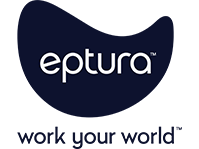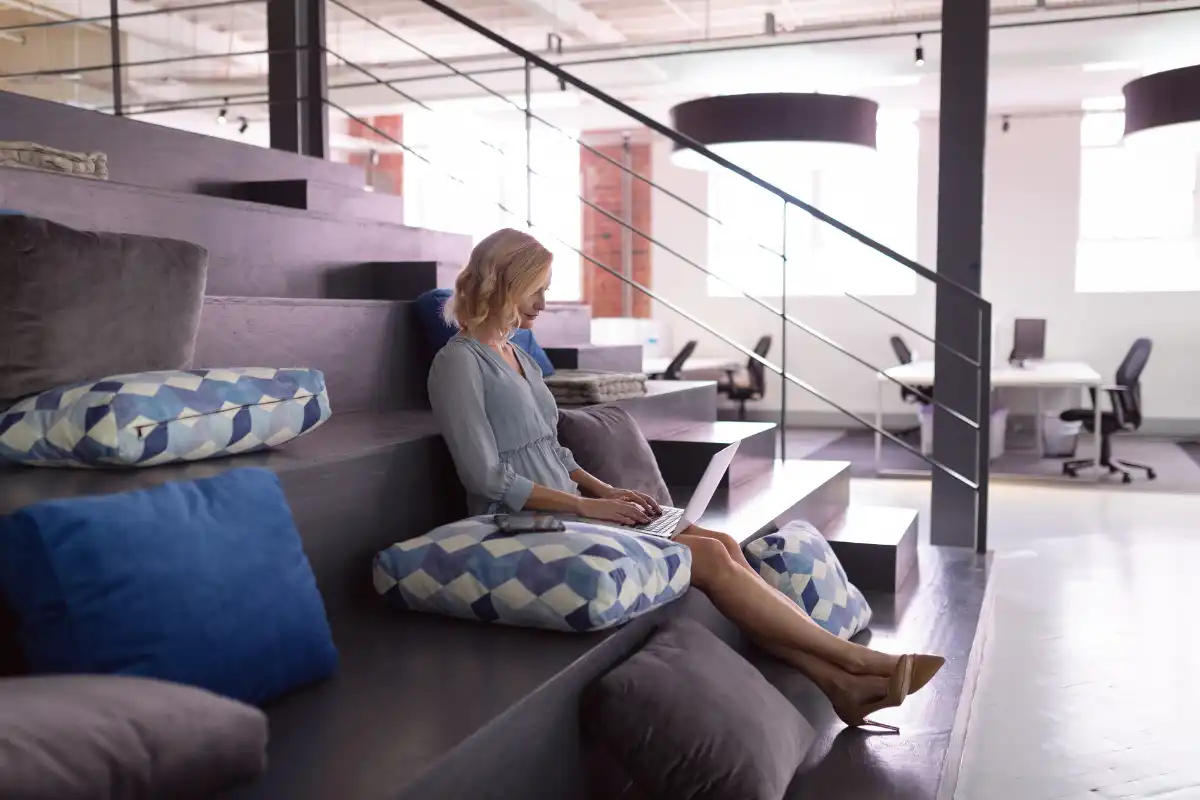
By offering flexible working arrangements, organizations can better attract, manage, and retain talent. In fact, 70% of employees want their employers to continue offering flexible remote work options, according to a global survey of 30,000 people across 31 countries.
Successfully implementing flexible work, though, means more than updated HR policies. Organizations also need to invest in the intelligent worktech solutions that make flex spaces work.
What is flex work and how does flex space support it?
Flexible work offers employees the freedom to choose when, where, and how they work. This can include flexible hours, remote work options, and the ability to work from various locations within or outside a traditional office.
Although often seen as synonymous, there are differences between hybrid and flexible work. Hybrid involves a structured blend of in-office and remote work, where employees have specific days to be on-site. The assignments are often based on department, location, or role, ensuring that teams can collaborate effectively while also providing some level of remote work flexibility. The model helps companies maintain a consistent presence in the office, which can be crucial for certain business operations and team dynamics.
Flexible work allows employees to tailor their workday based on their productivity rhythms, team responsibilities, and personal circumstances. For example, an employee might choose to work from home on days when they need to focus on deep, uninterrupted tasks and come into the office on days when collaboration and face-to-face interaction are more critical. This dynamic resource model makes the workplace more adaptable and responsive to individual and team needs.
Flex spaces facilitate flexible work by providing a variety of work environments and amenities that accommodate different work styles and needs. These spaces offer diverse work settings, where employees can choose from a range of work areas, such as quiet desks, private offices, and collaborative spaces, depending on the nature of their tasks and their personal preferences.
They also offer real-time availability. Workspace booking systems allow employees to reserve spaces in advance or on the spot, ensuring that they always have access to the resources they need.
Flex spaces enable employees to work more flexibly, which can lead to higher job satisfaction, better work-life balance, and increased productivity. This, in turn, supports the broader goals of flex work, making it a valuable tool for modern businesses.
Why is flex work popular with large companies?
For employers, flex delivers cost savings and operational efficiencies, including:
- Reduced overhead: Companies can significantly reduce overhead costs associated with maintaining a large, fixed office space. By utilizing flex spaces, employers can minimize expenses related to rent, utilities, and office supplies
- Optimized space utilization: Flex spaces allow for more efficient use of available office space. With a workspace booking system, companies can ensure employee utilize all spaces to their maximum potential, reducing the need for excess square footage and associated costs
- Scalability and flexibility: Employers can scale their workspace needs up or down based on the company’s current requirements. Flexibility is particularly beneficial for growing businesses or teams with fluctuating workloads, as it allows for cost-effective adjustments without long-term commitments
Offering flex spaces also improve employee satisfaction and retention. 38% of Millennials, 33% of Gen X, and 32% of Gen Z consider flexible working options as a top priority, according to research. And 44% of those who temporarily exited the workforce but later returned cited workplace flexibility as the primary reason for their return. By providing flex spaces, companies can see higher job satisfaction and lower turnover rates, ultimately saving on recruitment and training costs.
For enterprise-level organizations with large real estate portfolios, all these benefits multiply across facilities.
What do flex spaces look like at large enterprises?
Because companies design them to support different work styles, flex spaces look different from offices for employees following the more traditional Monday-to-Friday, 9-5 workweek.
Open and collaborative environments
Flex spaces often feature an open floor plan with a variety of seating options to accommodate different work styles and needs. The open layout encourages interaction and idea exchange, making it ideal for teams that thrive on collaboration.
Lounge areas provide comfortable seating and relaxed environments for informal meetings and breaks, while quiet zones are designated areas for focused work, often soundproofed to minimize distractions.
Private offices are also available for those who need more privacy or a dedicated space for client meetings. Meeting rooms are versatile and can be booked for various purposes, from small group discussions to large presentations. These rooms are often equipped with modern technology and can be reconfigured to suit different needs, ensuring that every meeting is productive and efficient.
Adaptable, flexible spaces
A common feature of flex spaces is adaptability. The employees can change the layout to accommodate different projects, teams, and work styles. Desks, chairs, and other furniture can be moved and rearranged to create different setups, allowing members to tailor their workspace to their specific needs. Teams can expand or contract workstations based on the number of people working together, making it easy to adjust to changing needs.
Some flex spaces even have dedicated event spaces for hosting workshops, social gatherings, and other events. Lockers and shared storage areas are also common, providing a secure place for members to keep their belongings without the need for a permanent desk.
What are some of the key software features that support flexible spaces?
To fully realize the potential benefits of these spaces, companies need to integrate intelligent worktech solutions like advanced booking systems, real-time occupancy tracking, and smart collaboration tools, so both companies and employees can navigate and utilize flex spaces efficiently and effectively.
Workspace booking
For employees, workspace booking systems offer a seamless and efficient method to reserve the space that best matches their specific needs and tasks. Flexibility enables employees to select the most suitable environment for their work, leading to increased productivity and job satisfaction. The ability to book spaces in advance also helps employees plan their day more effectively, reducing stress and enhancing their overall work experience.
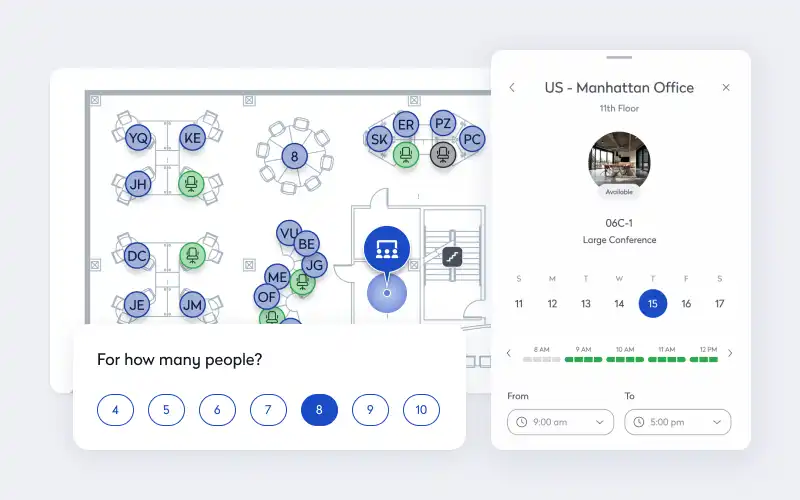
For facility managers, workspace booking systems are essential tools for managing and allocating workspaces in flex spaces, particularly in large companies. These systems provide real-time availability and booking options, allowing facility managers to optimize space utilization and reduce the administrative burden of managing space requests. By identifying underutilized areas, facility managers can make informed decisions to improve space efficiency and minimize conflicts.
Meeting room screens
For employees, meeting room screens eliminate the guesswork and frustration associated with finding an available meeting room. The digital displays provide real-time updates on room availability, enabling employees to book rooms on the spot and reduce the time spent on administrative tasks. Immediate access to this information ensures that meetings start on time, leading to more productive and efficient use of everyone’s time.
Meeting room screens also offer facility managers a clear and centralized view of room usage, simplifying the management of bookings and resolution of scheduling issues. These screens also help in identifying underutilized rooms, allowing for better space optimization and resource allocation. By streamlining the booking process, facility managers can enhance the overall efficiency and organization of the facility.
Desk screens
Desk screens provide a clear and up-to-date view of available workspaces, which is particularly beneficial in hot desking environments where employees do not have a fixed desk. By being able to see which desks are free, employees can quickly find a suitable workspace.
For facility managers, desk screens are valuable tools for monitoring desk usage and identifying patterns. A data-driven approach enables facility managers to make informed decisions about space allocation and layout, ensuring that the workspace is optimized for the needs of the company and its employees. By automating the desk booking process, facility managers can reduce administrative tasks and improve the overall efficiency of the workspace.
Visitor management
Visitors can be pre-registered, and their arrival can be easily managed through the system, ensuring that employees can focus on their work and meetings without being interrupted by the logistics of visitor check-in. The system can also provide visitors with clear directions and information, making their experience more welcoming and distraction free.
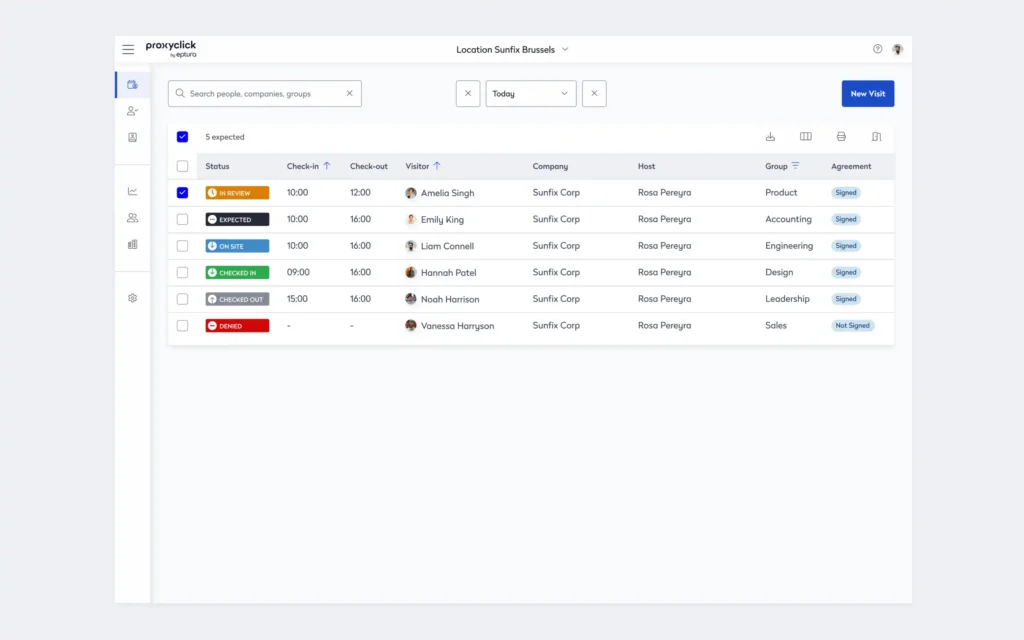
For facility managers, visitor management systems are crucial for maintaining security and order in flex spaces, especially in large companies. These systems allow for the tracking and management of visitor access, ensuring that all visitors are properly registered and have a valid reason for being on the premises. This not only enhances security but also streamlines the check-in process, reducing the workload on reception staff, and improving the overall efficiency of the facility.
Car parking management
Employees can reserve a spot in advance, ensuring that they have a place to park when they arrive at the office, reducing the time spent circling the parking lot. The system can also provide real-time updates on parking availability, making it easier for employees to plan their commute and avoid last-minute delays.
For facility managers, car parking management systems are essential for ensuring the fair and efficient allocation of parking spaces. These systems can track the availability of parking spots, manage reservations, and handle payments. By automating these processes, facility managers can reduce the administrative workload and minimize parking-related issues, such as overcrowding and disputes.
Successful flexible workspaces: How optimizing utilization saved £8 million on a London lease
A leading UK financial services organization, with a workforce of 3,000 employees and a diverse real estate portfolio that includes 150 high-street branches and four head office spaces, faced significant challenges trying to support hybrid work models.
One of the main issues was the need to enhance flexibility for employees, allowing them to work from various locations while maintaining productivity and collaboration. The company also struggled to optimize the utilization of its office spaces. The inefficiencies led to underutilized resources and increased operational costs.
To address these challenges, the company implemented integrated workplace management software to improve:
- Workspace booking
- Visitor management
- Car parking allocation
With real-time utilization insights, the property and facility management teams can now make data-driven decisions, ensuring employees have access to the resources they need. The company saw a smoother transition to the hybrid work model, making it easier for employees to book desks and meeting rooms, and for the company to manage the flow of visitors and parking spaces.
The company was able to leverage this new visibility into actionable insights, saving £8 million by optimizing their space utilization and reducing the need for additional office space.
“We’ve achieved remarkable improvements in both operational efficiency and employee satisfaction. With Eptura, we’re not just managing real estate—we’re transforming how employees experience the workplace,” explains the head of property and real estate.
